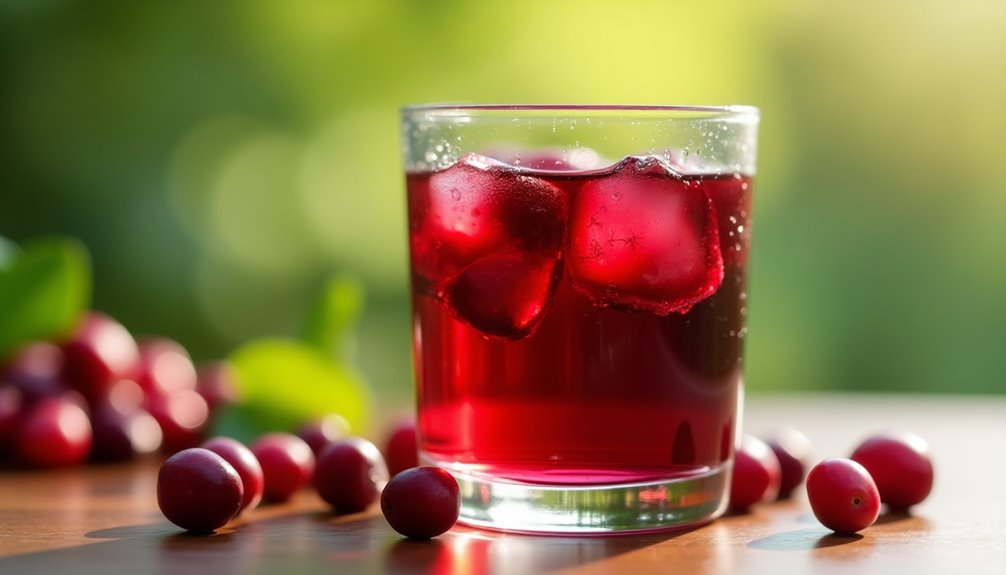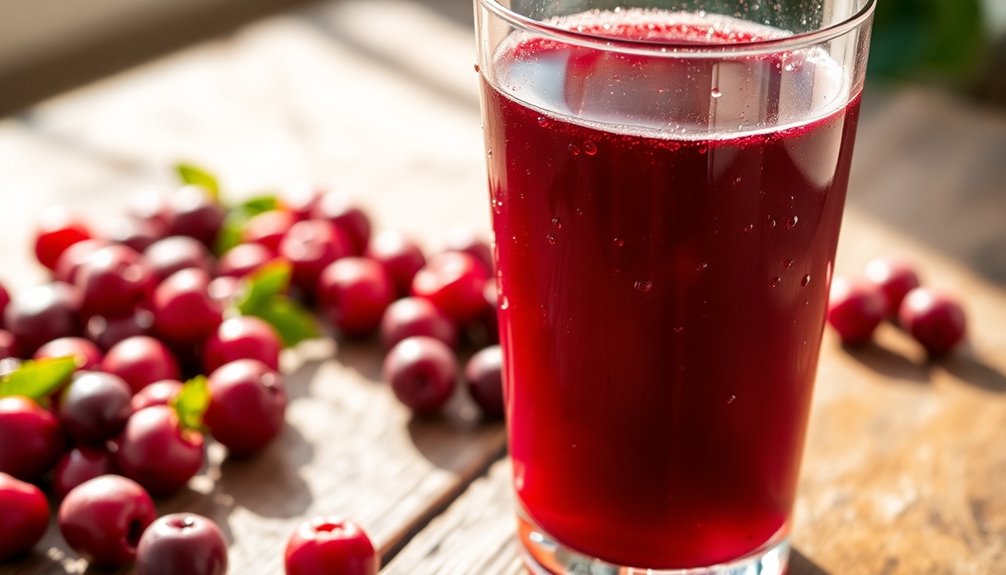Cranberry juice contains varying amounts of potassium, typically ranging from 30 to 150 mg per 8-ounce serving. Store-bought cranberry juice usually has about 40-50 mg, while pure cold-pressed juice offers 120-150 mg. Cranberry juice cocktails tend to have lower potassium, around 30 mg per cup. The type of juice you choose makes a big difference in its nutritional content. If you're curious about the health benefits and ideal consumption, there's plenty more to discover.
Key Takeaways
- Store-bought cranberry juice contains 40–50 mg of potassium per 8-ounce serving.
- Pure cold-pressed cranberry juice offers a higher potassium content of 120–150 mg per 8-ounce serving.
- Cranberry juice cocktails typically have around 30 mg of potassium per cup.
- Potassium levels in cranberry juice vary significantly based on the type of juice.
- Always check nutrition labels to determine the potassium content in cranberry juice.

When you reach for a glass of cranberry juice, you might be surprised to learn just how much potassium it can pack. Many people think of cranberry juice primarily for its refreshing taste or its renowned benefits for urinary health, but it also offers a notable potassium content that can be beneficial for your overall well-being. Depending on the type of cranberry juice you choose, the potassium levels can vary widely, so it's wise to pay attention to what you're drinking.
Store-bought cranberry juice typically contains about 40–50 mg of potassium per 8-ounce serving. While that’s not a huge amount, it can still contribute to your daily potassium intake. If you opt for pure cold-pressed cranberry juice, however, you’re in for a treat. This type of juice boasts a higher potassium content, ranging from approximately 120–150 mg per 8-ounce serving. This option not only provides more potassium but also retains more of the natural nutrients found in cranberries, including vitamin C and antioxidants. Additionally, the higher potassium content in cranberry juice can be particularly beneficial for individuals looking to support heart health and muscle function. When choosing between options, it’s important to read labels carefully to understand the potassium content in cranberry juice, as some brands may add sugars or other ingredients that could dilute its nutritional benefits. Incorporating pure cold-pressed cranberry juice into your diet is a flavorful way to boost your potassium intake while enjoying the unique taste of this tart fruit.
On the flip side, if you reach for a cranberry juice cocktail, you might be disappointed. These drinks often contain added sweeteners and are diluted, which lowers their nutritional benefits. With only around 30 mg of potassium per cup, juice cocktails can leave you lacking in this essential mineral. This variance is why reviewing nutrition labels is essential. You want to ensure you're getting the potassium you need, especially if you're focusing on your health and considering options for managing high blood pressure.
Potassium plays a crucial role in maintaining healthy blood pressure levels and proper muscle function. For individuals needing to increase their potassium intake, pure cold-pressed cranberry juice can be a beneficial option. Just remember, moderation is key. Consuming large quantities of any juice can lead to digestive discomfort, so it's best to enjoy it as part of a balanced diet.
Additionally, cranberry juice is rich in antioxidants, which can help combat oxidative stress in your body. The combination of potassium, vitamin C, and antioxidants makes it more than just a tasty drink; it's a powerhouse of nutritional benefits. Including cranberry juice as part of your daily routine can support your health goals, especially when you're mindful of the types of juice you're consuming.
Frequently Asked Questions
Does Cranberry Juice Have High Potassium?
Cranberry juice does contain potassium, but it isn't considered high in comparison to other sources.
Store-bought varieties usually have around 40–50 mg per 8-ounce serving, while pure cold-pressed juice can offer more, about 120–150 mg.
If you're looking to boost your potassium intake, you might find pure juice more beneficial.
Just remember, it's not enough to rely solely on cranberry juice for your daily potassium needs.
Always check labels for specifics!
Which Fruit Juice Has the Lowest Potassium?
When you're looking for fruit juices with low potassium, lemon juice stands out. Typically, it contains around 30 mg of potassium per 8-ounce serving when diluted.
Apple juice and white grape juice also have low levels, with apple juice providing about 100 mg.
Always check nutrition labels, though, as potassium content can vary significantly between brands. Making informed choices helps you manage your potassium intake effectively.
How Much Potassium Does Ocean Spray Cranberry Juice Have?
When you pick up a bottle of Ocean Spray cranberry juice, you'll find that the potassium content varies.
Typically, their regular cranberry juice has about 40–50 mg per 8-ounce serving.
If you go for the pure cranberry juice, you might see higher levels, around 120–150 mg.
On the other hand, cranberry cocktail drinks often have lower potassium, sometimes as little as 30 mg.
Always check the label for the most accurate information!
Is Cranberry Juice Good for Your Kidney Function?
Cranberry juice can be good for your kidney function. It helps support urinary tract health, potentially preventing harmful bacteria from sticking to the urinary tract.
If you're managing potassium levels, cranberry juice offers a low-potassium option, making it suitable for those on restricted diets. However, you should consult your healthcare professional to ensure it fits your dietary needs, especially if you have kidney disease or other health concerns.
Conclusion
In the grand scheme of fruit juices, cranberry juice might just be the unsung hero of potassium! Packed with this vital mineral, a single cup can deliver enough potassium to make your muscles sing and your heart dance. While it won't replace a potassium-rich diet, it's a delicious way to get a boost. So, next time you sip on that vibrant red goodness, remember you're not just treating your taste buds; you're fueling your body with a potassium powerhouse!
Cindy thoroughly researches juicing trends, techniques, and recipes to provide readers with practical advice and inspiration. Her writing style is accessible, engaging, and designed to make complex concepts easy to understand. Cindy’s dedication to promoting the advantages of juicing shines through her work, empowering readers to make positive changes in their lives through the simple act of juicing.











